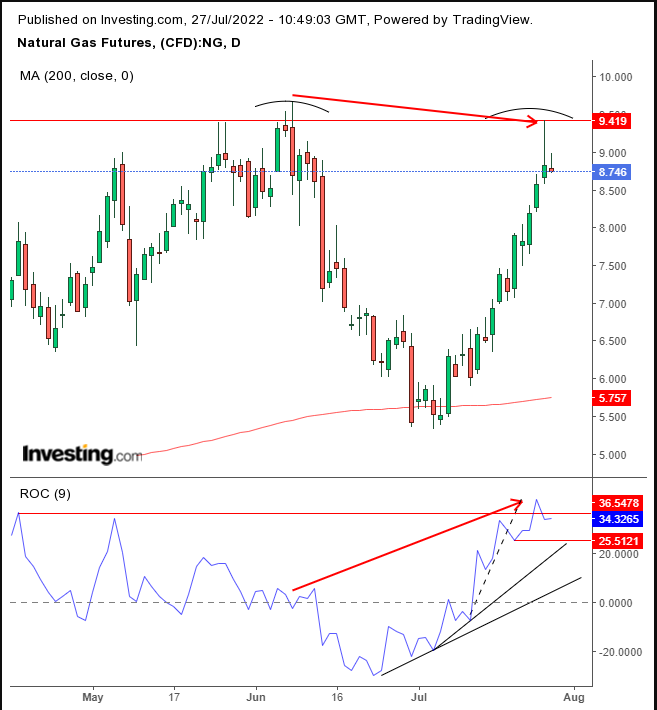Natural gas has touched its highest level since 2008 in July, putting the commodity on track for its strongest month on record, as Russia cuts supply and the heat wave continues.
However, the price closed very well off its highs, suggesting weakness.

The price action on Tuesday formed a potentially exceptionally bearish Shooting Star. I am limiting my enthusiasm to "potentially" due to its small lower shadow, which might have already shaken out some bulls.
While the rally on Tuesday was the third straight day, the Japanese characterize an instrument whose price action develops a shooting star to be "rising in agony."
This pattern occurs when bulls overextend and bearish say "we don't think so" and push back.
A shooting star is not a significant reversal pattern. However, coupled with the resistance of the previous peak, a 14-year high, it increases the downside risk. Moreover, note that yesterday's highs failed to overcome or even match the previous high. Therefore, even a minor retreat now could gather steam and turn into a more significant reversal.
Note the Rate of Change, a momentum-based indicator, is more sensitive to the more popular Relative Strength Index.
The price may have peaked from an overbought condition. After falling below its (dotted) uptrend line, that fanned out of its uptrend (which is classically when an instrument declines or at least tempers its ascent). It may have found resistance by the previous highs (horizontal red line).
Yesterday's peak was overbought, while the previous—higher—elevation had much more sustainable momentum, with ample upside room (Red arrows).
If the ROC falls below 25, it may complete a peak and trough reversal pattern, which would coincide with falling below the second fanned uptrend line.
If the indicator falls below its original uptrend line, it will have the 0 level in sight, which might signal that the price could follow suit toward its 200 DMA, a natural neckline to a Double Top.
Trading Strategies
Conservative traders should sit out, as they do not want to suffer the elevated risk of trading against the prevailing trend.
Moderate traders may risk a short position if and when the price retests the 9.4 level.
Aggressive traders may short at will, provided they can withstand the potential return to retest the resistance. That is why a tight trade plan addressing your timing, budget, and temperament is essential. Until you learn how to do that, here is a generic example:
Trade Sample - Aggressive Short Position:
- Entry: $9.00
- Stop-Loss: $9.50
- Risk: $0.50
- Target: $7.50
- Reward: $1.50
- Risk-Reward Ratio: 1:3
Author's Note: I'm not in the business of fortune telling. I am an analyst. I analyze the evidence and develop a prognosis. The principles I incorporate into my study are based on statistical outcomes. That means I cannot know whether this or any other individual trade will follow through on the presumed consequences. No trader, analyst, or investor knows the future. They operate on statistical assumptions, hoping that if they stick to a strategy tailored to their needs, they will eventually come out on top. It takes dedication, practice, and patience. So, before you take this trade, close your eyes and imagine it loses. If you can't handle that risk, do not take the trade. Happy trading.
